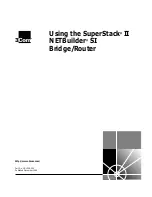
Server Cards
3-9
MCC Card
ACS-MCC Card User Screens and Settings
Table 3-4. Port Screen Option Settings and Defaults
Notes:
1. For ports C1, C2, and C3, the options are hdlc (default) and fr. For ports 1 to 128, the
options are b7r (default) and b4r.
STATE
The State setting determines whether the port is active or inactive. Set the State setting to
stdby (standby) for ports you are not using or have not yet configured. Set it to actv (active)
for ports that are ready for use.
WAN
The WAN setting identifies the WAN link on which the system information is sent. This signal
will come from either the distant system unit or the DACSII
. The options are none and w1-1
to w4-2. Ports 65 to128 are limited to WAN links w2-1 through w4-2.
TS
The Time Slot setting identifies the specific time slot on the WAN link (from the previous
paragraph) used for this particular port. The options are n/a, 1-24 (for T1 links) and 1-31 (for
E1 links).
IP ADDR
The IP Address setting identifies the IP Address of the remote end. Any unique valid IP
address is acceptable.
Parameter
User Options
Notes
Default
STATE
stdby actv
stdby
WAN
none w1-1 through w4-2
none
TS
n/a 1-24 1-31
n/a
IPADDR
ip
0.0.0.0
NETMASK
ip
0.0.0.0
FORMAT
b7r b4r hdlc fr
1
see note 1
RIP
off rx tx rx/tx
off
SH
off on
off
WEIGHT
1-15
1
Summary of Contents for 600
Page 1: ...Server Cards Reference Guide Release 5 3 1 September 2000 ...
Page 4: ...Model No Running Head ...
Page 10: ...vi Server Cards Model No Running Head Contents ...
Page 14: ...x Server Cards Model No Running Head Figures ...
Page 56: ...2 32 Server Cards Model No Running Head ACS FRS Server Card Specifications FRS Card ...
Page 74: ...3 18 Server Cards Model No Running Head ACS MCC Card Troubleshooting MCC Card ...
Page 110: ...4 36 Server Cards Model No Running Head ATM Server Card Specifications ATM Card ...
Page 150: ...5 40 Server Cards Model No Running Head ISDN PRI Card Troubleshooting ISDN PRI Card ...
Page 208: ...7 18 Server Cards Model No Running Head IMUX Card Troubleshooting IMUX Card ...
















































